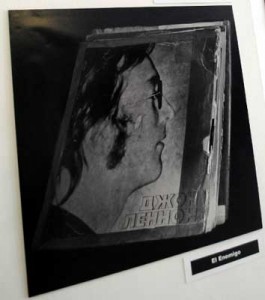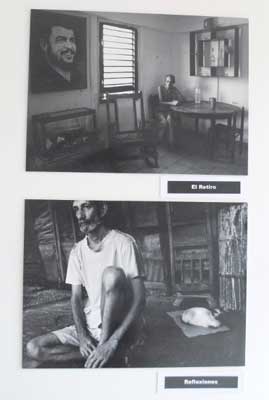‘The New Man’: An Uncomfortable Exhibition
By Irina Echarry
HAVANA TIMES, April 6 — The first thing that happened on Tuesday (April 3) as part of the XI Havana Youth Film Festival was the opening of the exhibit by James Prendes titled El hombre Nuevo (The New Man).
Prendes is a fairly unknown photographer but has an unquestionable quality, plus he’s playful. This is why his work turns out to be so entertaining – a game of tag between images and words.
Each photo is accompanied by a title that reinforces or completes it. Although the photos “speak for themselves,” it isn’t until we read the titles that the author conveys his true intention.
In this way, James Prendes playfully questions one of the most recurrent and readdressed myths of the revolution: the dreamt of “new man,” supposedly the ultimate result of the political and social transformations in our nation.
To accomplish this, he turns to the art and irony embodied in several sacred “revolutionary” icons and fetishes, as well as in unattainable utopias.
One photo is of a man sitting in a shoeshine chair placidly reading the “Guidelines” reform document of the Communist Party. The title is Disponible (available), which here in Cuba is the official euphemism for anyone who has been laid off.
 El Ultimo Hombre (The Last Man) shows us the picture of a balsero (rafter) at sea.
El Ultimo Hombre (The Last Man) shows us the picture of a balsero (rafter) at sea.
El Retiro (Retirement) speaks of the quashing of the individual and the role of myths.
El Chivato (The Informer) shows slightly cracked venetian blinds, behind which we know there’s someone watching.
An old album cover, letters in Russian and a picture of John Lennon are featured in El Enemigo (The Enemy).
A doctored photo of Marilyn Monroe dressed up as a Cuban Young Pioneer is titled Conquistando el Futuro (Conquering the Future).
These are images that question, stir up feelings and make us think about the need for myths.
The exhibit will be on display throughout this month in the lobby of the Charlie Chaplin Cinema at 1155 23rd Street.
Click on the thumbnails below to view all the photos in this gallery. On your PC or laptop, you can use the directional arrows on the keyboard to move within the gallery. On cell phones use the keys on the screen.

















The so-called “new man,” expected to develop under socialist state power, was a individual who would have been “cleansed” of the moral contamination of private property sentiments. This cleansing was supposed to occur by abolishing private productive property rights, and such property itself right away, by making all things productive the property of the new socialist state. The Marxian “therapy” was to immerse the citizen in a state-owned economy and thereby, little by little, cleanse her and him by a process of moral acclimation.
It hasn’t worked in any country that has tried it. What is most important is to understand why.
Marxism, like other strains of Utopian socialism, misconstrued the essence of capitalism as material incentives. Material incentives were seen as the great evil, and what supposedly would abolish this evil was to abolish private property and the material incentives that were part of it.
This however was and is a misunderstanding and falsification of the essence of socialism. The real essence of socialism is not the immediate suppression or abolition of private productive property. It is its democratization through cooperative enterprise structures for most significant enterprise for the proletariat–making the proletariat a new “associates’ class of enterprise owners–plus broad private ownership of small and medium enterprise for the non-monopoly bourgeoisie.
The “new man” thus be could developed by broadening and democratizing private productive property ownership, rather than the prompt abolition of private property according to a moralistic, Utopian concept. This would be by a gradual merging of the proletarian associates and the small business class over time, leading ultimately to a classless society. But Marxism smuggled the upper-class, Utopian misconstruction into the working class socialist movement, and no subsequent state monopoly ownership mode of production has been able to develop the hoped for “new man.”